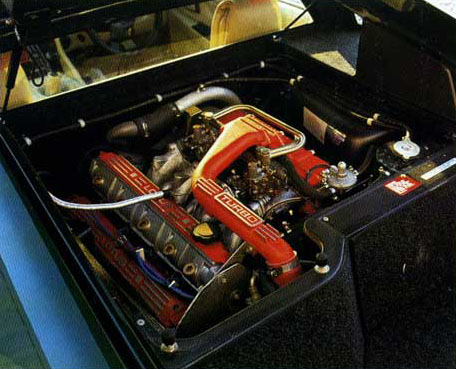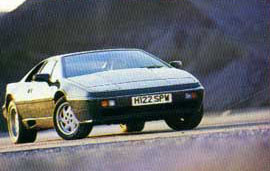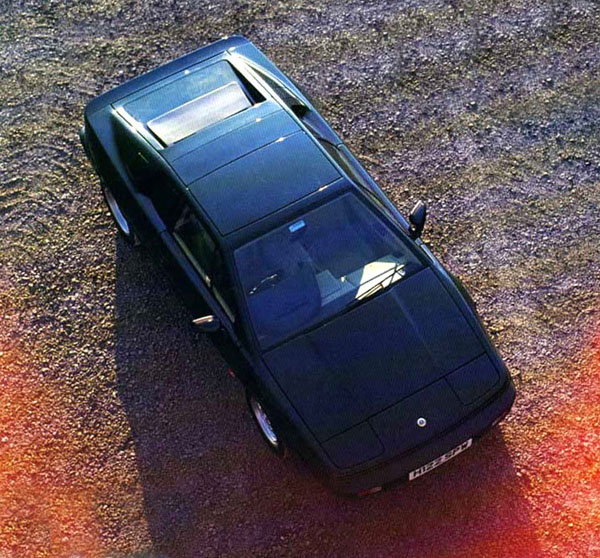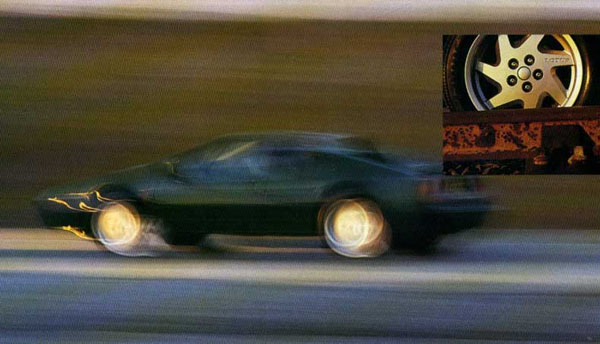
Fast Lane
Troubled Spirit - March 1991
It’s
always been a looker, the Lotus Esprit. So low and wide, it’s
pin – sharp Giugiaro lines first captured hearts at the Paris
Motor Show in October 1975. I remember thinking low exciting it
would be to have just one go in a car like this.
Later, when working at a garage, I had a chance to have that go.
It was a customer’s car in for a third set of rear wishbones
in four years, pot holes were to blame. An Esprit Turbo, it must
have been one of the first basic white cars built (after the extravagant
Albert Hall launch of the Turbo Esprit in 1980, the first 100 cars
were delivered in Essex Racing livery).
It was then that I realised just how impractical these cars were.
True, the mid-engined layout had been improved beyond all measure
from its humble start in the 1966 Europa. This was longer, wider
and the boot was bigger, but it was no load carrier. Then there
was the poor visibility (that left you squirming to see what was
behind you), the noise, the huge backbone chassis down the middle
of the car that restricts arm movement, not to mention the totally
invisible instruments. A reputation for fragility had lurked not
far behind the Esprit, as had Arthur Daly’s prophetic words
“I hear they fall out of bed, price-wise”.
By gum this car went. Howling up the wide Norfolk roads, it felt
jolly exciting. We were the men they couldn’t hang . . . at
least for two days. All the same, I remember thinking that the Esprit
was more impressive to spectators than owners. Just think of the
bills.
And so to this one, the base model 1991 Esprit, complete with a
Garrett TB03 blower feeding twin side-draught Delortos. The naturally-aspirated
Esprit is now dead, and the carburettor model tested here will follow
it when exhaust catalysts become mandatory next year (fuel injection
will be needed for the precise requirements of a three-way catalyst).
The engine is the short-stoke, 2.2-litre, four-pot, four-valve-per-cylinder
9105 unit, which delivers 215bhp at 6,000rpm and 215lb ft at 4,250.
Above this model are the fuel-injected, catalyst-equipped Esprit
S, which delivers 228bhp, and the mighty inlet chargecooled, injected
and catalysed Esprit SE which, with its 264bhp, is claimed to be
one of the world’s fastest cars, with a claimed maximum speed
of 163mph and 0-60mph acceleration of 4.7sec. That costs £11,400
more than the humble base Esprit (£24,900 including taxes),
however.
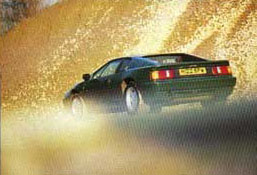
The engine drives into a transaxle-mounted five-speed manual gearbox,
originallydesigned for the Maserati-engined Citroen SM. Independent
rear suspension is via upper and lower transverse links, with trailing
links and coil springs. The front is via upper and lower wishbones
with coil springs and an anti-roll bar. Telescopic dampers are fitted
all round.
The comprehensively revamped body was launched at the Earls Court
Motorfair in October 1987. Updated completely in-house by Lotus,
the lines were softened and the car was given a more contemporary
feel. Lotus is justifiably proud of its handiwork, and it is true
that the chubbier flanks, blacked-out chrome and radiused curves
have brought the car up-to-date. I prefer the original though, with
its stark, almost folded edges and brutal looks. It was a statement,
something the restyled car can never be.
There is absolutely no question about performance, however. A blustery
day saw a mean of 148mph round Millbrook’s bowl, which validated
Lotus’s claims of 150mph, allowing for tyre scrub. The claimed
0-60mph time of 5.3 sec was matched exactly, helped a little by
a damp track, which allows the wheels to spin more freely, thus
keeping engine revolutions and therefore turbo boost high.
The in-gear acceleration times are just as impressive, although
the carburated engine cannot cope with very low speed acceleration
in the way that the fuel=injected models can. An example of this
is the 50-70mph increment, which in fifth gear takes 6.6sec, but
can be reduced to 4.3, or even 2.9 if fourth or third are used.
Even so, those figures mean that, 16 years on, Colin Chapman’s
plastic monster can happily exchange punches with all the most modern
mid-engined equipment written about elsewhere in this issue. It
can put an Aston Martin Virage into the shade (0-60mph in 6.5sec,
fourth gear 30-50 in 6.4, fifth gear 50-70 in 7.7) and can severely
embarrass the giant-killing Caterham 7 and Lotus’s own Elan
SE.
Out on the road, the low-speed coughing of the carbs is not really
a problem. No one really drives around at 20mph in fifth unless
they live in Worthing and wear a flat hat and, above 1,500rpm, the
Esprit can be relied upon to give smooth and relatively seamless
acceleration up to the 7,000rpm red line. Keeping the engine on
the boil is never a problem, especially with the quality of the
gear change, which belies its long throws to give fast and easy
shifts. The twin-cable linkage isolates the lever so that it is
difficult to tell whether the gears are synchronising properly,
but on the whole it is very good and massively better than earlier
models.
New for the 1991specification cars is standard anti-locking brakes,
which gives impressively high levels of retardation without cycling
the brakes, something Lotus was very keen on achieving. Despite
very hard braking on the road, the all-disc snit-locking system
never cut in. Only a brutal application on the Millbrook track started
the system, as which point it cycled the brakes perfectly adequately.
The latter are a bit lifeless, however. Their cold performance leaves
something to be desired, and only when they are properly warm can
snatch-free braking with proper levels of speed reduction be attained,
albeit without much feel and progression. Confidence is not helped
by the cramped footwell, which barely accommodates large feet. As
a general principle, Lotus wanted the Esprit to be the nearest they
could get “to a street legal Grand Prix car”; a careless
statement of the type that are thrown away by motoring industry
executives all the time. Certainly, Lotus wanted to give the Esprit
the high power-to –weight ratio and road holding that it has.
If you like, it gives Joe Public a motion about what a Grand Prix
car would be like . . .if they ever got a chance to drive in one.
In theory, the mid-engined configuration gives a lower polar moment
of inertia, which should help to give a lower resistance to changes
in direction and a better response to corning and steering inputs.
It should also allow a more equal front/rear weight distribution,
getting closer to the magical 50/50 percent split, which equalises
some of the demands made of the front and rear suspension.
These features on their own do not confer good handling (there are
intervening factors like suspension design and performance, tyre
slip angles and yaw), but they do help. Mid-engine layouts unfortunately
suffer from other inherent problems. They can be twitchy, because
of the same low polar moment of inertia that gives them their quick
responses. They tend to have very high levels of roadholding, which
can encourage the uninitiated to travel faster than they are capable,
but they do not give the progressive warning signs of breakaway
that a front / rear-wheel drive car might exhibit. Rear suspension
designs are often compromised, because the engine and gearbox are
in the way. They are expensive as parts cannot be taken from ordinary
cars, and they can be cramped, because the layout invariably takes
up a lot of passenger and luggage room.
To answer some of the earlier criticisms, Lotus has dialled quite
a lot of feel into the steering system of the Esprit and some understeer
into the chassis. The steering still feels heavy and a little dull
(a criticism of Lotus), despite all the information that reaches
the driver through the wheel at even low to medium speeds and it
will still not tell you with sufficient warning when you are about
to slide off (a criticism of the mid-engined layout).
With a trailing or steady throttle, the Lotus will understeer hard,
but not as hard as the turbo models with their slightly different
weight distribution and suspension setup. Small amounts of throttle
will pull the nose into line, but the tail of the car can be brought
round all too easily without due care.
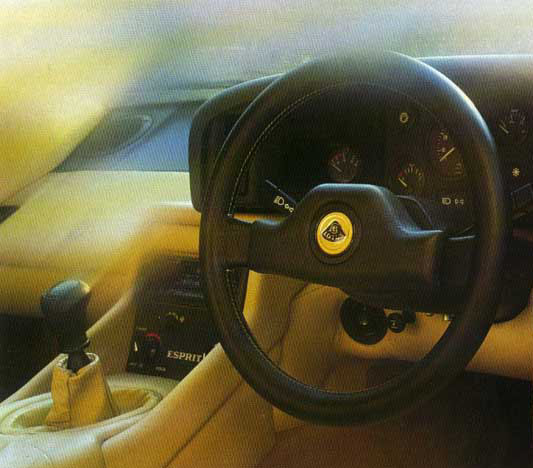
Inside the cockpit, the car is awkward and dated. High on the list
of impracticalities is the inability of anyone over 6ft to see any
of the instruments or switches, except the cigar lighter and the
rather tacky ice warming gauge. “Good evening Officer. No
I have no idea what speed I was doing, but you must be jolly cold
out there, have a cigar.” The very poor side and rear visibility
(in spite of the large rear-view mirrors), bent spoon driving position
and central chassis tunnel, which traps your elbow when trying to
steer, must also be cited.
Whether or not the idea of a weekend jaunt with your Mistress in
a high-performance two-seater (with room enough for a pair of tooth
brushes and camisole) is dated, could be argued. If it isn’t,
then it must have been Elvis serving the fish and chips last night.
Also long gone is the Victorian street sweeper, who would clear
a crossing in the road for those who could pay. Even rich people
get their feet dirty nowadays, and light cream leather upholstery
and carpets must be one of the most impractical ways to finish the
inside of any car. Black or dark grey would be just as attractive,
and more practical.
Although it is getting on a bit, the Esprit can still match the
performance of many other mid-engined supercars. Lotus has revisions
in hand that will increase the grip, power and keep the Esprit up
to date with the best. Interior aside, it is a pretty good example
of the mid-engined genre. It seems a shame that this blown carburettor
model has only a short period left before catalysts become mandatory
and fuel injection is needed.
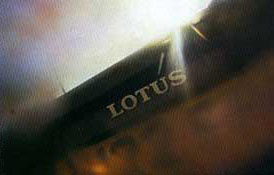
But is the mid-engined car an anachronism? It recalls a period in
the 1970s when men really existed who thought they could defy the
laws of nature. Every week, series like Mission Impossible and Department
S promoted a myth that the latest technology could be tamed by men
with Zapata moustaches and enormous medallions. With a wide, open
road, and considerable courage, the mid-engined layout is supremely
capable; probably more capable than any other engine/drive configuration.
In practice, however, with tight roads, and less than perfect surfaces,
the poor early warning inherent in the layout, lack of visibility
and high potential speeds mean that, if one gets into trouble, even
split-second reflexes will not help you regain control before you
plough a country bus stop or end up on the wrong side of the road;
you’ll be going too fast, and need too much road to get it
back into line. Lotus admitted as much when it dialled artificial
understeer into the chassis to provide a margin of safety, which
it undoubtedly does.
Lotus test engineers also freely admit the latest Elan SE, even
with less power, is a faster A-to-B car. You can see out of it,
it communicates early enough to do something about it, it’s
cheaper and large people can drive it too.
My feelings have not changed about the Esprit in spite of the improvements
made. It is still a better car to admire than to own.
